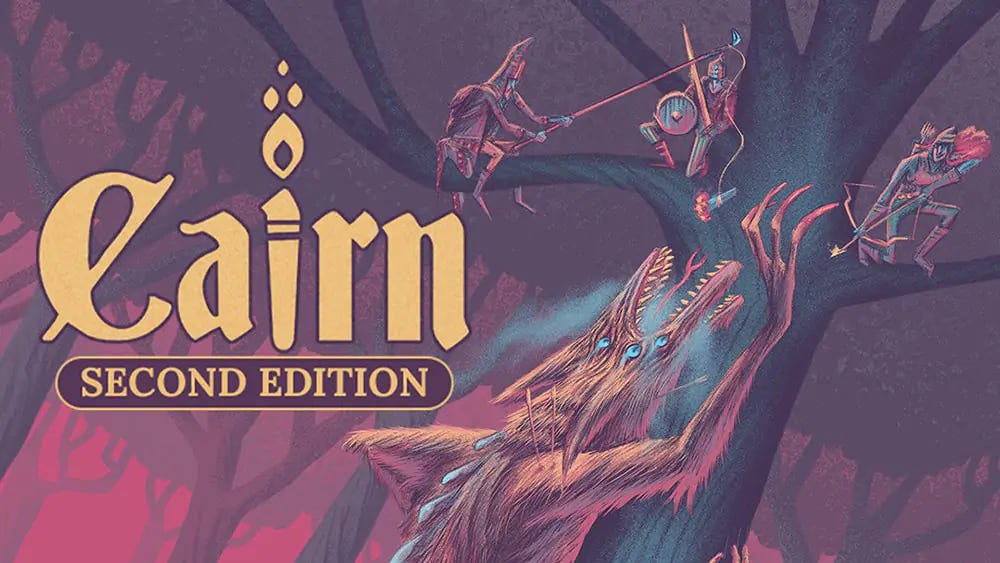Settings, not system
Why you should focus on the vibes, and not the rules.
Greetings fellow warlocks!
In a previous letter, we discussed about the importance of “vibes” over rules. Today we will be taking a step further and analyze why we should focus on the settings, not the system.
In this letter:
🪐Settings, not systems
🎲 Rules should support settings
👀 Narrative games to make a good Setting
A PREMISE
Before we begin, my fellow witches, let me clarify one aspect:
As a game designer, I would never underestimate the importance of writing a good rule set.
This blog post is not saying you should play a single ruleset and only one set.
So before you bring out your torches, I am not telling you should play Cyberpunk 2020 in D&D 5e.
Rules, however, are a tool. The real player of the game is always the setting, in my opinion.
SETTINGS, NOT SYSTEMS
As said in the previous Tome of Oddz letter, I believe the reason I keep coming back to some good games is their vibes. I cited the Electrum Archive by Emiel Boven, a good game with an emphasis on its wonderful setting.
Now I want to take a step further and tell you this; the setting should always be the crucial part of your games, not their rules.
I started formulating this thought while I was listening to an interview to Yochai Gal on Dieku Games (which I highly recommend). Yochai Gal is the author of Cairn 2e, one of the games I love the most.
While discussing why he created Cairn, he said this:
”The reason I made Cairn was so I could stop thinking about system. I feel like there’s an emphasis on ‘system, system, system, let’s make systems’. But the FKR (editor’s note: Free Kriegspiel Renaissance) people, they have one thing right: it’s ‘Settings, not systems’ . You just need a basic framework.”
These words struck me, because they resonated a lot with my thoughts lately. As I said in the beginning, the games I like and I keep coming back, are the games with good settings (or vibes if you wish to call them that).
RULES SHOULD SUPPORT THE SETTING
Of course, I do not mean you should absolutely stop writing rules if you are a game designer, that would be silly.
However, if you are a narrative player like me, you should always emphasize the setting, and build rules around them.
No matter if you are a published game designer, or simply the author of a homebrew setting for your group of friends, you should think of rules as a mere tool to achieve the narration of your setting, not as the main aspect of your games.
One of my best friends, which is a long-time RPG player, once summarized this for me in a sentence that I always keep in my mind when I write games and settings:
”As long as rules don’t get in the way of fun and narrative, I don’t really have strong opinions about what RPG systems we are using.”
This, especially from the perspective of a player and not a GM or game designer, is what really matters at the end of the day. It’s the setting, the narrative, the fun.
The rules are just a tool to support those good settings, they are the vehicle you and your players use to explore these fantastical worlds.
As long as that vehicle runs you through memorable narrative moments, does it really matter what engine uses?
Take a moment and think about it; the best memories of your RPG career, do they involve rules, or moments in the narrative and the in the exploration of fictional worlds?
Okay, now that we realized we love settings over rules, what are some tools we can use to run (or make, if you are an author!) a good setting?
NARRATIVE GAMES FOR MAKING A GOOD SETTING
First and foremost, in my opinion the best game systems to run good settings are the less crunchiest, or if you wish, the “Rules-lite” systems.
As a proof, the wonderful Electrum Archive by Emiel Boven, has just 26 pages of rules in a 68 pages book. There are 42 pages of artworks, lore, and random tables goodness.
So whether you are a seasoned game designer looking to hack a system for your new cool setting, or an author looking for a system to run your setting with friends, here are my top picks:
Cairn 2e
Of course I could not talk about Yochai Gal without mentioning Cairn. Cairn 2e is a fast, simple, and very “functional” fantasy game. It works with a classless system that uses backgrounds as a starting point instead. The second edition adds a lot more material for campaign play, and new interesting backgrounds.
One of its strength is also how easy is to convert adventures from other games for Cairn.
This is also why I mentioned it is very functional; Cairn is super easy to customize and hack, to the point that many games were based on this system and they vary a lot in genre, like Runecairn Wardensaga, or Cyber.
The game is completely free, and free to hack thanks to its license. Best of all, you can get a printed version for dirt cheap at amazon or Lulu!
Songs and Sagas
Do you want an even LIGHTER rules-lite game? Well, look no further than Songs and Sagas by FariRPGs. It uses one of the easiest fantasy game systems I have ever seen, with a focus on narrative play, and it’s played with both cards and dice.
I am a little biased with this one because, well, I used it for a game!
I have hacked the Songs and Sagas rules to make a solo game called Hellgreen, and to show you its flexibility, Hellgreen is set in a modern paranormal setting reminiscent of the Vietnam War era!
You can also find a game that looks straight out of the Borderlands video game,
Wastewalkers!
Once again, Songs and Sagas is free to download, and free to modify, hack, and create!
Mothership RPG
While the first two games were more on the fantasy side, Mothership by Tuesday Knight Games brings us into the sci-fi realm, and does it with a simple and straightforward system. Despite the main game relying on the sci-fi horror genre, the game system works for all sorts of sci-fi and cyberpunk sub-genres. In fact, you can find all sorts of third party content for Mothership, ranging from sci-fi westerns to gritty cyberpunk modules.
Making stuff for Mothership is easy and fun, I highly recommend it if you are an author who’s building a setting and looking for a game to explore it.
For game designers, making and selling third party content for Mothership is possible, although it requires you to send the product for review at Tuesday Knight Games, so keep that in mind.
Shadowdark RPG
Back to fantasy with one of my favorite games of 2024, Shadowdark by Arcane Library. I absolutely adore the style and gameplay of this one, and I have been loving playing it solo with SoloDark.
Shadowdark is easy, deadly, and super-fun. The core rules are simple to grasp, and there is a ton of helpful material for worldbuilding.
It’s getting very popular in the OSR and NSR scenes, and occasionally you may even see some of my stuff in the game’s Reddit or Facebook group!
You can create a setting compatible for Shadowdark with ease, and as long as you don’t copy-paste the game’s rules, you can even publish them.
As such, you’ll see a ton of creative folks out there making Shadowdark content, and once you read it, you’ll see why!
I hope these games are a good starting point for creating your own settings and games! I will be gathering even more material for a possible sequel to this blog post, but in the meantime, go make some good settings and have a great day!








Agreed! Give me a world where the story cuts deep, and I’ll make sure everyone leaves with scars worth keeping. Systems are tools. Setting is the altar where we decide what’s worth sacrificing.
I’m hoping to write for Shadowdark soon! Such an adaptable system!